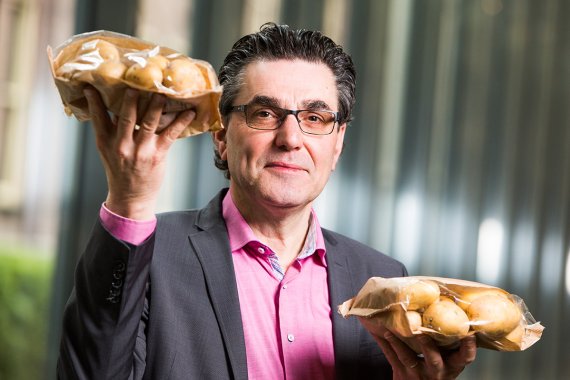SP MP Henk van Gervan wants to know what it will take to keep on feeding the growing world population. Photo: Freek van den Bergh
Question Time for Resource

They are used to posing their questions to the cabinet, but now Dutch parliamentarians also get to ask Resource a question that Wageningen scientists might be able to answer. In this edition, a question from Socialist Party MP Henk van Gerven: Can we feed the world through traditional plant breeding?
The world population will grow to 9 billion in the next few decades. And in many parts of the world people’s diets are set to change: more meat, less plant-based food. In 2050 we shall therefore need 60 percent more food than we do now, according to calculations by the world agriculture organization FAO. Is that possible without gene technology?
Yes, in theory it is, responds Martin van Ittersum, professor at Plant Production Systems in Wageningen. He calculated the ‘yield gap’ – the difference between actual and potential agricultural production – for various regions of the world. So he knows whether there is scope for increasing production. In Africa, where the biggest population growth is expected, there is plenty of scope. ‘In most African countries farmers are achieving 20 to 30 percent of the production level that would be possible with optimal crop management. By way of comparison: Dutch farmers operate at 80 percent. So there is plenty of scope for boosting agricultural production.’
Richard Visser, professor of Plant Breeding, agrees that we have the capacity to go on feeding the world, ‘seeing the current level of production in many developing countries and the massive scale on which food gets wasted.’ Crop breeding plays an important role in raising agricultural production. ‘Fifty percent of the potential production increase can be achieved through plant breeding, and the other 50 percent through mechanization, for example, or the use of artificial fertilizer and better soil and water management. I expect breeding will continue to increase harvests, because we are gaining a better and better understanding of complex characteristics such as drought and salt tolerance, which make harvests more reliable.’
Painfully slow
So it is feasible, if you just look at the physical conditions for agriculture. But it worries Martin van Ittersum that the actual production growth in many developing countries is painfully slow. ‘It appears to be very difficult to get agricultural development started in areas with low production rates. That’s because you’ve got to change a lot of things at the same time.’
The first thing that strikes you in Africa, for instance, is the poor soil fertility. That can sometimes be improved with more artificial fertilizer, but sometimes there are systemic problems with the soil, such as a shortage of organic matter or high acidity. Then you need major levels of investment over many years if you want to improve the soil fertility, says Van Ittersum.
The next problem is the management of diseases and pests. This is something you can address with crop protection and plant breeding, says Van Ittersum. ‘So you combine better seeds with soil management, sufficient nutrients, weeding, recycling of crop waste, and a system of crop rotation. This is actually the familiar system we use in the Netherlands, but you need to keep on improving on it.’
Socio-economic factors play a role in raising production too. Do farming families have enough land, knowledge, time and machinery at their disposal? Van Ittersum: ‘Many farming families in Africa have less than one hectare of land. That is not enough to get an income out of it and to invest in agricultural development at the same time. And then we still have the agricultural infrastructure, with its markets, prices, politics and economic limitations.’
Social issues
‘There’s the rub,’ says Wageningen professor Phil Macnaghten, who studies the introduction of new technologies. ‘Whether we can feed the world is not a technological question. We have to look at the social, ethical, institutional, political and cultural aspects of the food supply. All those aspects are locked into agricultural systems around the world. To get results, we’ve got to understand those socio-cultural aspects and create the conditions for agricultural development and a viable, healthy environment. To do that we need to enter into a public debate about which technologies people need, and what advantages they see in new technology.’
MacNaghten wrote a book about the lessons we can learn from the introduction of genetically modified crops in Mexico, Brazil and India. He thinks the discussion focuses too much on the question of whether GMOs are safe for our health and the environment. He says we should be asking whether farmers and the population stand to benefit from new technology. ‘Just look at the public perception of medical biotechnology: everyone knows that it saves lives. Compare that with the prevailing opinion on agricultural biotechnology: that it doesn’t benefit the public, only Monsanto’s sales of pesticide.’
Van Ittersum agrees with Macnaghten on this point. ‘The problem with GMOs is that the companies made big promises, but that the first large-scale use of GM was to create herbicide-resistant crops. GMOs may well have led to an increase rather than a decrease in the use of pesticides. I don’t object to GMOs, but they should form an appropriate part of a whole set of measures for increasing agricultural production sustainably.’
Breeding goals
Plant breeder Richard Visser shares the view that food technology should benefit society. He sees no problem with working on a GM crop that offers greater food security under dry conditions. He is pondering possibilities for crops such as potatoes, cassava and fruit trees as well: ‘These are all crops for which it takes a very long time to develop a good variety. In such cases adding a resistance gene, for example, which retains all the positive things about the original variety, is a very good idea. You can do that with new techniques such as cisgenesis and Crispr-Cas.’
Visser thinks our licensing policy should not make distinctions between techniques – whether or not they involve GM – but between the goals of the breeding. ‘The discussion in Europe is extremely fixated on the technique, whereas countries such as Australia and Canada assess breeding on the end product: is that safe for people and for the environment? Given the technological developments of today, that seems to me the best approach.’
But assessing safety alone is not enough, repeats Phil Macnaghten. ‘Maybe we want those GM crops, but we do not fully understand the social impact of this technology, because it is not embedded in a social context. On the one hand, consumers do not feel part of a discussion about this technology and are taken by surprise, while biotechnologists on the other hand can’t see the limitations of their technological perspective.’

